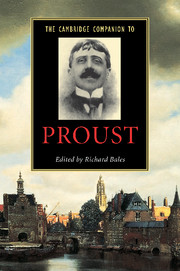Book contents
- Frontmatter
- Introduction
- 1 From Belle Epoque to First World War
- 2 The vast structure of recollection
- 3 Ruskin and the cathedral of lost souls
- 4 The birth and development of A la recherche du temps perdu
- 5 Lost and found: the structure of Proust’s novel
- 6 Proust’s Narrator
- 7 The unconscious
- 8 The texture of Proust’s novel
- 9 Proust’s human comedy
- 10 Proust and social spaces
- 11 Love, sexuality and friendship
- 12 Proust and the fine arts
- 13 Proust and posterity
- Postlude
- Select bibliography
- Index
8 - The texture of Proust’s novel
Published online by Cambridge University Press: 28 May 2006
- Frontmatter
- Introduction
- 1 From Belle Epoque to First World War
- 2 The vast structure of recollection
- 3 Ruskin and the cathedral of lost souls
- 4 The birth and development of A la recherche du temps perdu
- 5 Lost and found: the structure of Proust’s novel
- 6 Proust’s Narrator
- 7 The unconscious
- 8 The texture of Proust’s novel
- 9 Proust’s human comedy
- 10 Proust and social spaces
- 11 Love, sexuality and friendship
- 12 Proust and the fine arts
- 13 Proust and posterity
- Postlude
- Select bibliography
- Index
Summary
If someone were to suggest that the texture of Proust's novel resembles nothing quite so much as molasses, it would be difficult to dissent with any great conviction. The over-long book, with its over-long sentences, over-long paragraphs, over-long sections and over-long volumes, is as thick and viscous as treacle, and little more transparent; it expands not only in all directions but also, and especially, in every dimension, so that its excess is ultimately one of density rather than one of magnitude. And its sweetness, as one of its earliest tasters was quick to point out, is best sampled in very small doses. 'Reading cannot be sustained for more than five or six pages,' writes Jacques Normand; 'one can set down as a positive fact that there will never be a reader hardy enough to follow along for as much as a quarter of an hour, the nature of the author's sentences doing nothing to improve matters.' Forced to compose a report for the Fasquelle publishing house in 1912, the same Normand ends up reduced to exquisite despair. ‘After the seven hundred and twelve manuscript pages,’ he complains, ‘after infinite amounts of misery at being drowned in a sea of inscrutable developments and infinite amounts of maddening impatience at never returning to the surface – one has no notion, none, of what it’s all about.’
- Type
- Chapter
- Information
- The Cambridge Companion to Proust , pp. 117 - 134Publisher: Cambridge University PressPrint publication year: 2001
- 1
- Cited by



